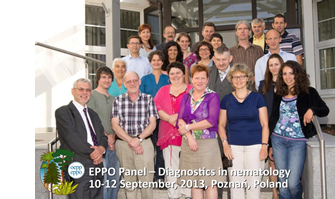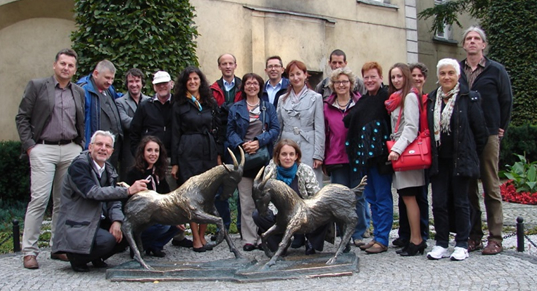
9th Meeting of the Panel on Diagnostics in Nematology
Poznan (PL), 2013-09-10/12
The Panel on Diagnostics in Nematology met at the Institute of Plant Protection, National Research Institute, Poznan. T he Panel continued its work on the preparation and revision of diagnostic protocols.
he Panel continued its work on the preparation and revision of diagnostic protocols.
The Panel finalized the horizontal Standard on Nematode Extraction following late comments, which had received provisional approval from the Council. This will be published in the EPPO Bulletin in December 2013.
Revisions of several protocols were considered during the Panel meeting:
- The protocol on Bursaphelenchus xylophilus was reviewed following an enquiry from Ms Abelleira (Estación Fitopatolóxica de Areeiro, Deputacion de Pontevedra in Pontevedra, Spain). The Panel responded to her comments and considered how the protocol could be clarified in a future revision.
- The protocol on Aphelenchoides besseyi was reviewed and corrections and additions, including the possible addition of 2 molecular methods, were discussed. A new version of this protocol will be produced by the end of the year with the objective to send it for country consultation in early 2014.
- The protocol on Globodera rostochiensis & G. pallida is under revision to add a new real-time PCR test developed by Fera. This new section was reviewed and comments sent to the author so it could be finalized. A Dutch report on the conventional PCR test (Bulman & Marshall) was considered and this will be written up by the author as an article in the EPPO Bulletin. Additional information on morphology that the Panel would considered to be useful to have in the protocol will be added to the next version. An Erratum will be published in the EPPO Bulletin to correct a mistake concerning annealing temperatures and to correct the primer concentrations in the current version of the protocol.
- Two new techniques were presented which could potentially be added to the protocol on Meloidogyne chitwoodi and M. fallax however the Panel considered that there is not enough validation data to add these now. A revision will be prepared for the next meeting.
- A revision of the protocol on Ditylenchus destructor and D. dispaci was presented to the Panel. This revision adds D. gigas which has been recognised as a separate species. The morphology and new molecular tests were presented.
- Suggestions were made for the revision of the protocol on Radopholus similis. A new key and table will be developed. The addition of molecular tests will depend on validation data.
- The Panel considered the protocols on Heterodera glycines, and on Hirschmaniella spp. and considered that these should be revised at the next meeting.
- A revision of the protocol on Xiphinema americanum sensus lato was presented to add 3 new species. Once the suggestions made have been implemented this will be sent for country consultation later this year.
The Panel made suggestions for the pictorial glossary and this will be updated by the end of 2013 and a link will be added to this in all new or revised diagnostic Standards in Nematology.
The Panel was informed of the latest developments concerning the EPPO Panel on Diagnostics and Quality Assurance, in particular on progress on the Standard Guidelines for the organization of interlaboratory comparisons by plant pest diagnostic laboratories, on the collection of validation data and on the revision of the EPPO standard PM 7/98 on Specific requirements for laboratories preparing for accreditation for a plant pest diagnostic activity.
A document on Barcoding of nematodes was provided by Mr Frey (ACW, CH) and Mr Helder (WU, NL) and this led to discussions on suitable regions for barcoding (coding/non-coding). The Panel responded to the document but decided to keep a pragmatic approach for the many EPPO Protocols which use molecular tests based on ITS regions as part of the identification process. If these tests have validation data showing they work well, they should be kept. If better tests are developed based on other areas then they will be replaced if the performance criteria justify this.
A EUPHRESCO project on extraction and real-time PCR for M. enterolobi was presented.
The Panel reviewed the Table on nepoviruses in the EPPO Standard PM 4/35 Soil test for virus vector nematodes in the framework of EPPO Standard PM 4 Schemes for the production of healthy plants for planting of fruit crops, grapevine, Populus and Salix. Suggestions were made and a new table will be developed.
Possible additions to the Alert list were discussed by the Panel and a demonstration of the validation section in the EPPO Database on diagnostic expertise was made.
The next meeting will be held in February, 2015 in the EPPO Headquarters in Paris.

